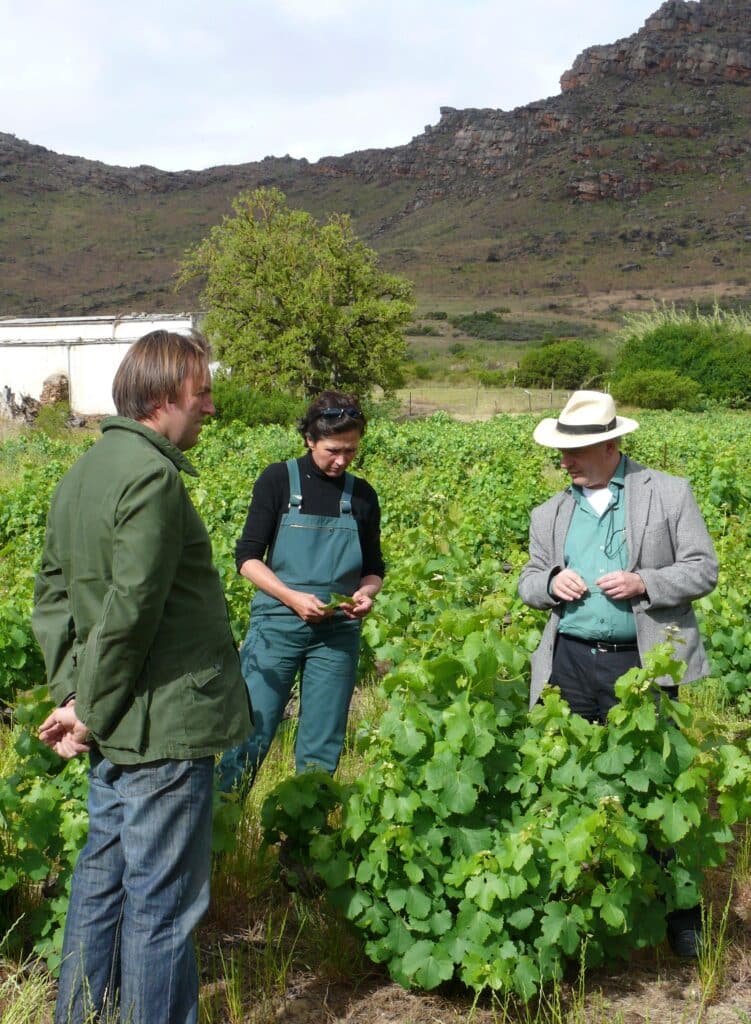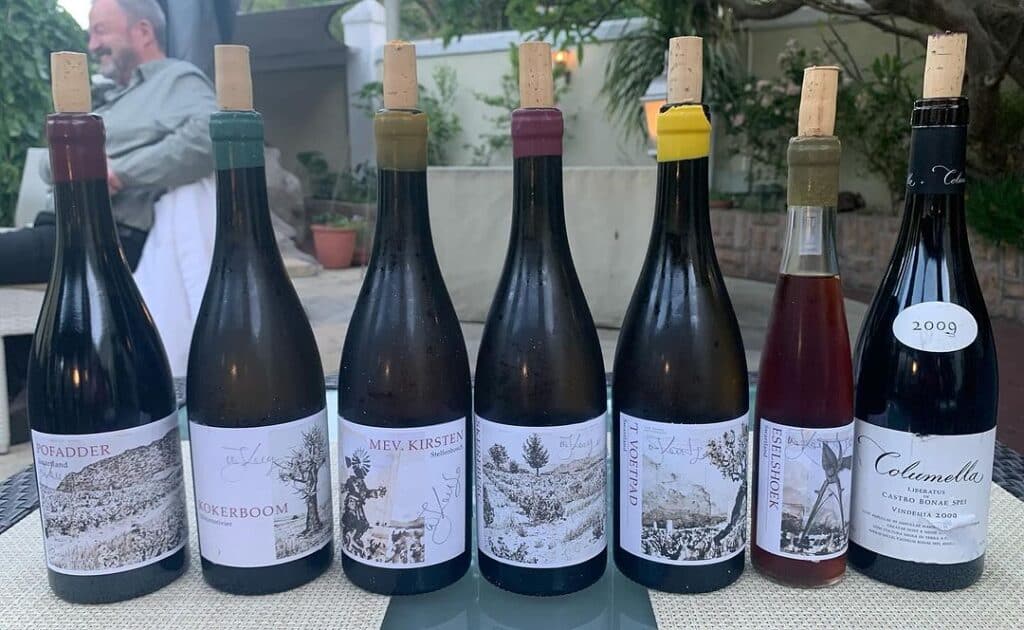Tim James: The maiden Sadie Ouwingerdreeks wines celebrate 15 years
By Tim James, 18 November 2024

3

On Saturday I took what felt like the momentous step of opening my set of six Sadie Ouwingerdreeks wines from the maiden vintage, 2009. The bottles (one a half-bottle) were still wrapped in tissue paper in their specially made wooden case, but I knew the hidden labels were signed by William Kentridge, the artist who’d come down to visit the vineyards that gave the wines and be thus inspired to make the drawings shown on only that first release. Eben Sadie’s signature was on the “back” label bearing all the details.
I’d last sampled all six of these wines five years ago at a tasting organised by Angela Lloyd on the tenth anniversary of the vintage. Now they were fifteen years old and I confess to a touch of uncertainty. Had I held on to them too long? Fifteen can be quite elderly for white wines, which four of these were, along with one cinsaut and a sweet wine made from hanepoot (the half-bottle of Eselshoek, which was soon dropped from the series because the vines were just too few). Half-a-dozen people, including Angela, Eben, and viticulturist Rosa Kruger who’d introduced Eben to her beloved vineyards, were to drink the wines accompanied by a specially prepared dinner at Aubergine restaurant in Cape Town. My wariness was slight, but sufficient for me to also take along a bottle of Columella from the same vintage, and ask Eben to bring a 2009 Palladius. That way we’d surely be certain of having enough drinkable stuff at dinner, as well as looking at the entire 2009 Sadie range.
In fact, nervousness soon disappeared, and the quality of the wines exceeded my best hopes, with no special pleading needed.
The release of the 2009 Old Vine Series, and its local and international success, can now be seen as a seminal moment in Cape wine, the most significant new range of wines yet produced in post-1994 South Africa. There had been one or two pioneering wines trumpeted as coming from old vineyards (including chenin from Irina von Holdt’s Old Vines Cellars, and semillon from Boekenhoutskloof and Landau du Val), but with nothing like this focus and variousness, with the expression of vineyard exposed by unintrusive winemaking, with such sheer quality.
The Columella and Palladius blends had epitomised an earlier stage in the modern Cape wine revolution, but the time was right to announce a new stage that the revolution had been working its way into for some years on a wide basis. There was a developing concern with exploring terroir via single (and preferably mature) vineyards, with Rosa’s search for old vines a significant part of it. There was also a new confidence in recovering earlier traditions of South African winemaking. Sadie’s Pofadder cinsaut was arguably the first serious modern Cape wine from this variety; Kokerboom announced the “rediscovery” of the local red mutation of semillon. And perhaps, generally, taking further the fine work already done with chenin blanc (not only in the Swartland), the preponderance of white wines in this important release further challenged the claims of red wines to be the grandest product of Cape vines. Also worth mentioning is the total reliance on Afrikaans on the labels – something far from uncommon now, but few back then had the confidence to do it for wines seeking an international audience (Hermanuspietersfontein the pioneer, I think).

So to the wines on the evening (and a day later, as I took away the bottles – precious little in some of them for a retaste). While celebrating the general longevity and gains in the wines over 15 years, it must be pointed out that the bottles had been very well stored. If they’d been in the kitchen cupboard it would almost certainly have been a different story. Something else to note is that, while sommelier Ralph Reynolds didn’t chill the wines, it was often mentioned that they improved with warming a bit in the glass. Beware of serving white wines too chilly – especially more complex, ambitious ones. I’ll mention them, briefly and inevitably inadequately, in the order Ralph served them with Harald Bresselschmidt’s great food.
Skurfberg, back then from three chenin vineyards in the area now from just one, also served as an aperitif. Plenty of time, then, to happily explore its subtle aromatics and flavours (including waxiness and Eastern spices) and rich texture; bright acidity, beautifully dry. I always enjoy what seems like an oxymoron: delicious austerity, and that was here, with a lovely sweet core from the fruit ripeness that, Eben insists, this wine needs.
The Stellenbosch chenin, Mev Kirsten, joined Skurfberg for a crab dish. This is the only one of the wines that long preceded the Series, though it was Englishly named Mrs Kirsten up to then. Shyer, less exuberant than Skurfberg, also less ripely rich. This wine was in 2009 in a sort of transitional period between the quirky oxidativeness of the earlier vintages (which I had loved) and the cleaner refinement of later ones (which I possibly loved even more). A deeper gold hue pointed to the past. This wine took time to open up, I thought, though its fresh elegance and fine balance immediately pleased and the inherent power was apparent in the length of quiet flavour. In fact, this was the wine that I found most benefited from a further day – though the gently forceful savouriness after 24 hours would probably not appeal to everyone as much as it did for me. Rather like an “orange” wine, it was great with food from the start.
Kokerboom and Palladius came with a complicated dish of duck breast. The semillon from the Skurfberg area was profoundly beautiful; fragrant, energetic and long-lingering, with a notable phenolic bite. Drinking superbly for now and a while yet, I should think. Palladius, on the other hand, I thought was showing its age in some oxidative development. Still with a degree of freshness on the palate, but also a touch of sweetness (not as much as some earlier vintages and more than later ones with fresher varieties and earlier picking – again, this was a transitional vintage; I now enjoy Palladius most from 2011 onwards) that I didn’t enjoy in the context of the development.
Then came a dish with mushrooms and sweetbreads, neither my favourite ingredient, but the dish was sublime – helped by the Swartland field-blend ‘T Voetpad and the one red, Pofadder. I’m so deeply prejudiced in favour of Voetpad, because I love the place, that perhaps that’s partly why I enjoyed this one so much. Gorgeous, and stony dry with a little ker-ching of sweetness on the finish –perhaps from the muscat drop it had in those days. Firmly tannic, unsurprisingly: Eben says “All we’re farming there is skins and pips – there’s almost no juice!” (As I write, a day later, I couldn’t resist going for the last quarter-glassful, and it again comes close to bringing a tear to my eye and joy to my heart; I might not claim it is delicious, which is a quality not all that hard to find; Voetpad takes deliciousness and smashes it into wonderfulness, not so easily found, and not always wanted, I suspect; bizarrely, this wine is reminding me of a red wine, López de Heredia Tondonia Rioja).
After all that, what to say about Pofadder, which I suspect was probably the general favourite wine of the evening? To my surprise, and I think to Eben’s. Elegant, aromatic but not vulgarly so, unbelievably fresh and light-feeling despite an alcohol of 14.5%. This was undoubtedly delicious. There are also almost enough Cape cinsauts amongst the charming to persuade me that the few as superior as Pofadder can’t just be a fluke and that this is a potentially good and serious grape and worthy of more than accompanying cab in its ambitious moments. Well done, Eben, for noticing.
Columella 2009 followed with the beautifully prepared springbok sirloin. As for Palladius and Mev Kirsten, this was a transitional vintage towards greater precision, freshness and non-varietal complexity, a fine, rich but dry and almost elegant wine; unlike Palladius, still youthful with its best ahead.
And then, with a lovely soufflé for dessert (chef Harald Bresselschmidt hates it if I call it pudding), was the to-be-doomed Eselhoek, made from the hanepoot grapes in the remote old vineyard that produces ‘T Voetpad. But that doesn’t make me love it, though its deep copper raisininess is still pretty fresh and gorgeous. But who cares? Hanepoot is for eating, not drinking.
Pretty soon after that, it was time to go home. A good and memorable evening. I wonder what these maiden Ouwingerdreeks wines will be like at 20? Maybe better not go there. We have all the wonderful in-between vintages to enjoy. But on the basis of this experience, they too deserve, and will benefit from, some significant time before drinking.
- Tim James is one of South Africa’s leading wine commentators, contributing to various local and international wine publications. His book Wines of South Africa – Tradition and Revolution appeared in 2013.







Jos | 18 November 2024
I recently attended a Sadie vertical at the Old Vine Experience where we tasted the 2013’s vs the 2023’s and I was amazed how fresh the the whites were. We only had Skerpioen and Skurfberg on the white wine side, but they were by no means past their peak, despite it being a poor vintage for whites.
Just a shame you have to sacrifice your firstborn to get a bottle of Voetpad…
Kwispedoor | 18 November 2024
It would be so interesting to see how these wines evolve from here. The Columella seems to have plenty in store, but perhaps some of the others may reasonably be expected to start to fade at some stage over the next few years. Then again, perhaps not? The Pofadder in particular was a bit of a surprise. I did not expect it to still have some of those lovely lifted aromatics. To boot, Cinsaut has also been known to sometimes rise from the ashes after many years of ‘sleeping’… Wine is made for drinking, but so often one only gets a mere taste of this caliber of wine. What a wonderful experience and writeup, Tim!
Ashley Westaway | 18 November 2024
Thanks so much for this Tim! I agree with you; you facilitated a momentous occasion and have been kind enough to share some of the detail of your experience here. I’ve been commenting on my experience of old Sadies in a rather ad hoc way. See https://winemag.co.za/wine/opinion/tim-james-middle-aged-new-wave-producers-and-some-middle-aged-wines/. Also, I recently hosted a mini-vertical of Pofadder 2014 – 2016. One word on each: 2014 – charming; 2015 – balanced; 2016 – riveting.